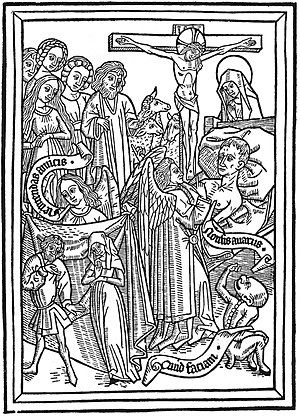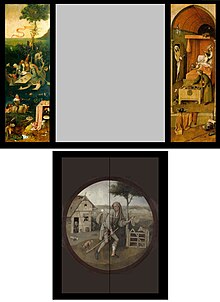This is an old revision of this page, as edited by Zexianna (talk | contribs) at 22:03, 20 November 2020 (Moving images again.). The present address (URL) is a permanent link to this revision, which may differ significantly from the current revision.
Revision as of 22:03, 20 November 2020 by Zexianna (talk | contribs) (Moving images again.)(diff) ← Previous revision | Latest revision (diff) | Newer revision → (diff)| Death and the Miser | |
|---|---|
 | |
| Artist | Hieronymus Bosch |
| Year | 1494 or later |
| Location | National Gallery of Art, Washington, D.C. |
Death and the Miser (also known at Death of the Usurer) is a Northern Renaissance painting by Hieronymus Bosch produced between 1490-1516 in Northern Europe. The piece was originally part of a triptych, but the center piece is missing. It is a memento mori painting, which is meant to remind the viewer of the inevitability of death and the futility of the pursuit of material wealth, illustrating the sin of greed. There is still debate about the exact symbolism of the man and the objects in the foreground. Bosch was influenced by the Ars moriendi, religious texts that instructed Christians how to live and die. It is currently held in the National Gallery of Art in Washington, D.C.
Description
Death and the Miser belongs to the tradition of memento mori, a term that describes works of art that remind the viewer of the inevitability of death. The painting shows the influence of popular 15th-century handbooks (including text and woodcuts) on the "Art of Dying Well" (Ars moriendi), intended to help Christians choose Christ over earthly and sinful pleasures.
The scene takes place in a narrow, vaulted room that holds a man on his deathbed, similar to the unclothed, thin, and sickly representation of souls in other Bosch triptychs. The skeletal figure of Death emerges from a closet on the left with an arrow pointed at the dying man. An angel lays a hand on the man’s shoulder, with a hand outstretched to the ray of light emanating from the window on the left, where a small crucifix also hangs. There is a nefarious creature holding a lantern peeking down from the canopy of the bed, while a “devil” offers the man a large sack of coin. These fantasy type creatures can be seen in many of Bosch's other paintings, most famously The Garden of Earthly Delights.
In the foreground, an old man dressed in green deposits coins into the sack of a demon in the trunk while gripping his cane and rosary in his left hand. The trunk contains worldly possessions: a knife, money, armor, a gold weight (that looks similar to a chess pawn), and envelopes, notes, or letters. Discarded garments and a winged demon figure are closer in the foreground, with other weapons and pieces of the suit of armor. The room is seen through a pointed archway flanked with columns, but the foreground appears to be outdoors. It is unknown what sort of structure the room is attached to, if any.
Subject and Interpretation
Death and the Miser combines different timelines into a single scene. It depicts the final moments of man called a miser, a hoarder of wealth, or an usurer, who gives loans while profiting from an often unfair interest rate. It’s widely accepted that the old man in green is a slightly younger version of the miser, in full health, storing gold in his money chest (which abounds with demons) while clutching his rosary, indicating both his desire for piety and wealth.
Usury was considered immoral and a great sin (a "sin against justice") in the early Renaissance period, mentioned specifically in the Bible in Luke 6:35, where Christ recommends free lending rather than profiting from the issuance of a loan. Medieval Church law followed these instructions and denounced usury as a practice and excommunicated members for it until the Council of 1516 passed montes pietatis (mount of piety), which stated that charitable institutions were allowed to issue low interest rate loans to the poor. This law implies that usury was not often practiced, but the opposite is true, and many people, poor and well-to-do alike, could not survive without a loan at some point in their lives. It became so common that authorities developed a modus vivendi, or agreement to peaceful coexistence, with pawnbrokers, then known as lombards (named after the region of their origin). It became so common and legal that they were regulated by authorities until a more fair and stable public loan policy was established in 1618.
The scene is highly reminiscent of an earlier illustration in the Ars moriendi where a dying man is cautioned about his avarice in chapters nine and ten of the book. In chapter nine, the man is tempted by avarice (greed) upon his deathbed, with his wealth shown by expensive treasures, similar to the trunk at the foot of the bed in Bosch’s painting. In chapter ten, an angel warns him of the dangers of avarice, telling the miser, “Protect yourself against the putrid and deadly words of the devil, for he is nothing but a liar… In the end everything he does is deceitful.” Here we see the angel with one hand upon the miser’s shoulder, lifting his other to the light of Christ, imploring him to make the Christian decision rather than succumb to temptation and sin. The crucifix in the window seen in the miser’s room is also a key feature of the Ars moriendi illustrations in these chapters, and reminds us how separate and disparate Christ is from all of the worldly troubles and possessions depicted in the room below.

Even with the angel's intervention at his bedside, as Death looms, the miser's gaze and hand are directed downward, unable to resist worldly temptations, reaching for the bag of gold offered by a temping demon. Whether or not the miser, in his last moments, will embrace the salvation offered by Christ or cling to his worldly riches, is left uncertain. This is in stark contrast to the Ars moriendi, where the angel successfully persuades him to embrace Christ. It implies that, rather than otherworldly creatures battling for the soul of a person, the decision lies in their own hand and no one else's.

Bosch's familiarity with the visual tradition of the Ars moriendi can also be seen in the top left roundel (pictured) depicting the death of a sinner in The Seven Deadly Sins and the Four Last Things. There are several points of similarity, such as the figure of Death and the juxtaposition of an angel and devil at the headboard. Death and the Miser could be Bosch's illustration of the sin of avarice, intended to be a part of this series, meant to depict each of the biblical deadly sins as shown through contemporary life.
Another interpretation of the gesture between the man and the demon suggests that the man is not only tempted by wealth, but is offering it to Death as a ransom. Usury was not just a display of avarice as a sin that simply required the offender to confess and seek God for forgiveness internally, but demanded a specific type of repentance. According to the Church, reparations for damages or reimbursement of monetary loss must be paid for this crime, but this is not something a miser on his deathbed would be able to do. He could, however, rectify this at the moment of death by providing this indemnity in his will, though this particular man shows no intention of doing so.
The conflict depicted here casts doubt on who exactly the man is supposed to portray. A lombard would not worry about his afterlife or any façade of piety, as they were excommunicated from the Church, publicly shamed, and denied sacrament and Christian burial. That this man is worried with at least an illusion of piety suggests that he may be a surreptitious pawnbroker rather than an obvious lombard. This concept is strengthened by the setting; an official lombard in Augsburg or Bruges, both hubs of Northern Renaissance merchants and artists, would have a normal place of business, akin to a small warehouse with a public facing office and storerooms to house and organize goods. The man in Death and the Miser does not have that, shown instead with pawned items scattered in his room and locked in a trunk, which indicate that he may want to keep these items and his activities a secret.

References
- https://www.nga.gov/collection/art-object-page.41645.html National Gallery of Art. Retrieved 23 Oct 2018.
- ^ Morganstern, Anne M. (1982). "The Pawns in Bosch's Death and the Miser". Studies in the History of Art. 12: 33–41 – via JSTOR.
- ^ Schlüter; Vinken, Lucy; Pierre (2000). "The foreground of Bosch's "Death and the miser"". Oud Holland. 114, No. 2/4: 69–78 – via JSTOR.
{{cite journal}}: CS1 maint: multiple names: authors list (link) - Schlüter; Vinken, Lucy; Pierre (2000). "The foreground of Bosch's "Death and the miser"". Oud Holland. 114, No. 2/4: 69–78 – via JSTOR.
{{cite journal}}: CS1 maint: multiple names: authors list (link) - ^ Morganstern, Anne M. (1982). "The Pawns in Bosch's Death and the Miser". Studies in the History of Art. 12: 33–41 – via JSTOR.
- ^ Schlüter; Vinken, Lucy; Pierre (2000). "The foreground of Bosch's "Death and the miser"". Oud Holland. 114, No. 2/4: 69–78 – via JSTOR.
{{cite journal}}: CS1 maint: multiple names: authors list (link) - Morganstern, Anne M. (1982). "The Pawns in Bosch's Death and the Miser". Studies in the History of Art. 12: 33–41 – via JSTOR.
- Fiero, Gloria K. "The Humanistic Tradition Fifth Edition". 130
- A Moral Tale, Webmuseum, Paris.
- De Tolnay, Charles (1966). Hieronymus Bosch. New York: Reynal. ISBN 9780517255254.
- Hand & Wolff, pp. 17-8
- Morganstern, Anne M. (1982). "The Pawns in Bosch's Death and the Miser". Studies in the History of Art. 12: 33–41 – via JSTOR.
- ^ Morganstern, Anne M. (1982). "The Pawns in Bosch's Death and the Miser". Studies in the History of Art. 12: 33–41 – via JSTOR.
Sources
- Hand, John Oliver; Wolff, Martha. Early Netherlandish Painting. National Gallery of Art, Washington. Oxford University Press, 1987. ISBN 0-521-34016-0
| Death and mortality in art | |||||
|---|---|---|---|---|---|
| Themes | |||||
| Forms |
| ||||
| Artwork | |||||